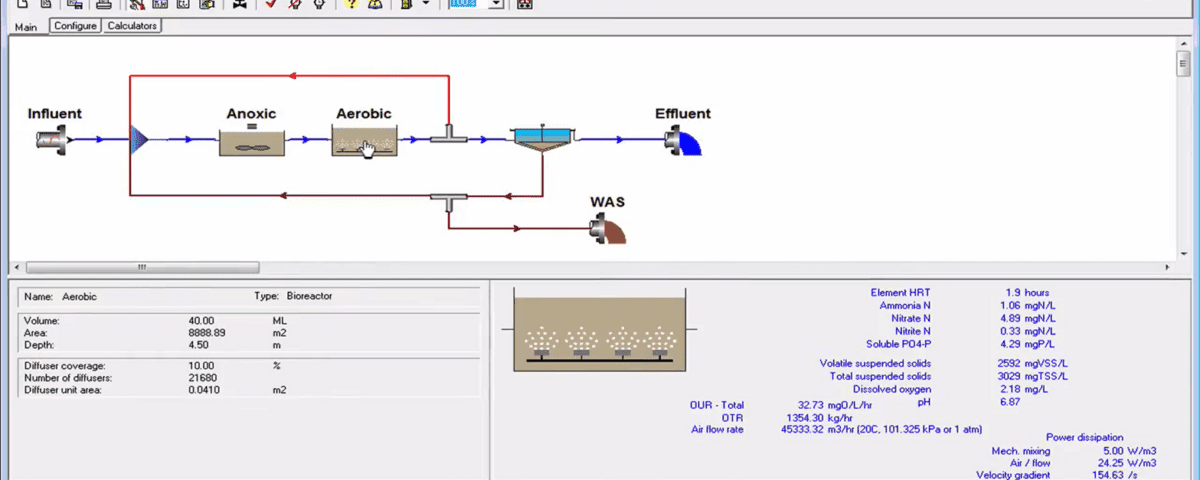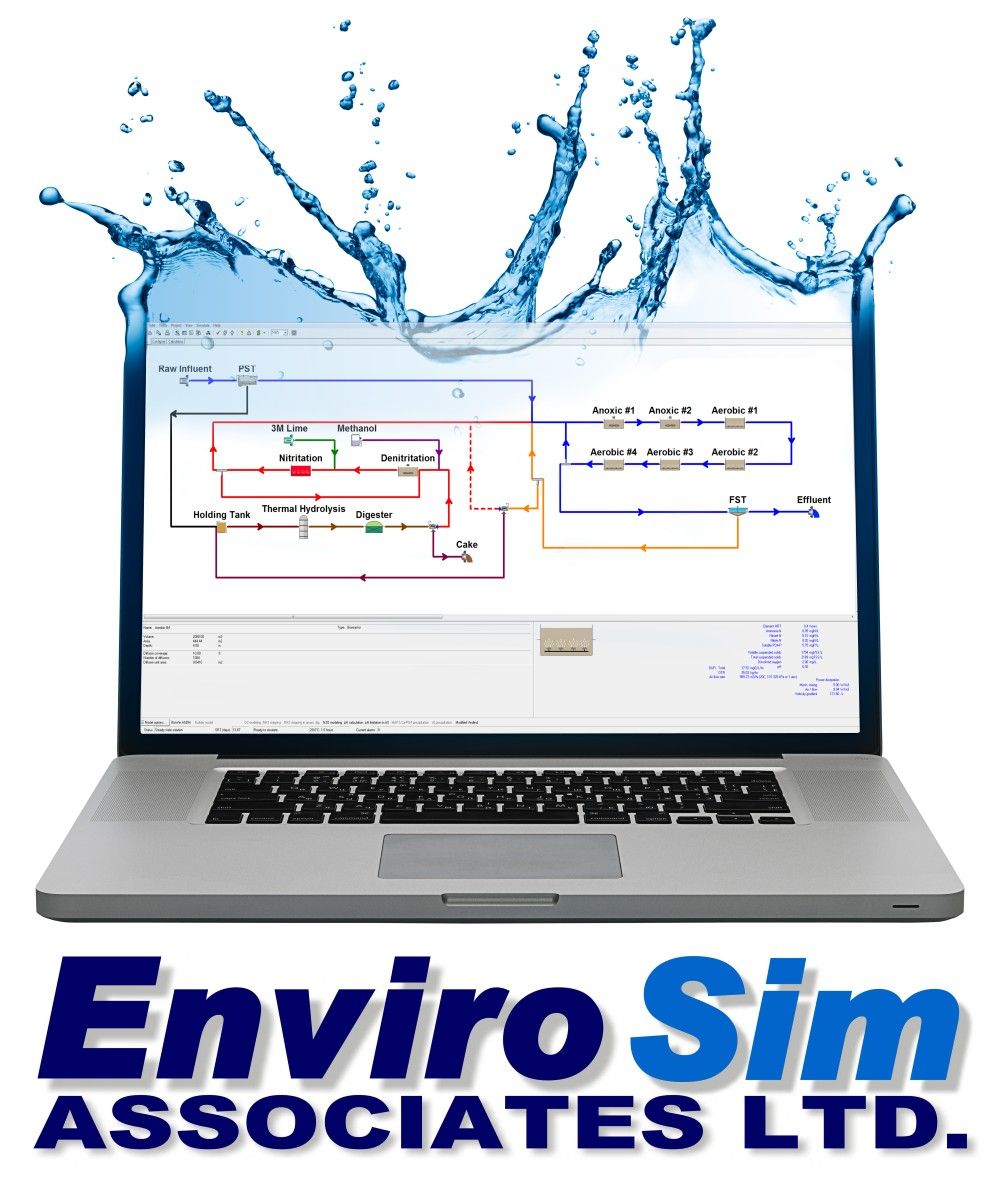Introduction
EnviroSim BioWin is a specialized software for simulating chemical and industrial wastewater treatment processes. It incorporates a variety of chemical, physical, and biological models and methods for wastewater treatment. By using this specialized chemical engineering wastewater treatment plant design software, which you can download from Jam Chemistry, you can advanced simulate biological, chemical, and physical processes in wastewater treatment and then achieve your desired results.
When using EnviroSim BioWin, you can simplify your simulations for easier use and better results with various tables and charts. You can also examine water chemistry models for pH calculations, mass transfer models for oxygen modeling, and other gas-liquid reactions
Advantages and Disadvantages
Advantages:
- High Accuracy: Advanced mathematical models and an extensive database provide high accuracy in simulations.
- User-Friendly: The graphical user interface and visual tools simplify the design and analysis process.
- Wide Range of Process Support: Supports a broad spectrum of processes, from aerobic and anaerobic to solids separation and chemical effects prediction.
- Customization: Biological and chemical parameters are adjustable, allowing models to adapt to real-world conditions.
Disadvantages:
- High Cost: The software license cost can be high for small companies or individuals.
- Requires Expertise: Users need in-depth knowledge of wastewater treatment processes for optimal use.
- Limitations for Very Large Scales: Simulating large systems can be time-consuming.
- Dependency on Accurate Input Data: The accuracy of results heavily depends on the quality of initial data.
Applications of BioWin in Small and Large Wastewater Treatment Plants
BioWin, as one of the advanced tools for simulating wastewater treatment processes, has extensive applications in both small and large treatment plants. In small-scale plants, this software helps optimize system design to achieve the desired output quality with minimal costs and resources. This is particularly important for small communities, villages, and industries with limited scales.
For small wastewater treatment plants, BioWin can be used for:
- Simulating simple activated sludge systems with minimal equipment.
- Optimizing nutrient removal processes to prevent environmental impacts.
- Designing low-cost processes for small communities with limited resources.
In contrast, in large urban and industrial wastewater treatment plants, BioWin plays a crucial role in managing the complexities of multi-stage systems. This software can assist in:
- Simulating multi-stage processes involving aerobic, anaerobic, and solids separation.
- Analyzing and managing high organic load scenarios and wastewater flow variations.
- Optimizing energy consumption and reducing operational costs in large systems.
- Designing advanced nitrogen and phosphorus removal systems to comply with environmental standards.
EnviroSim BioWin Software Environment
One of the standout features of EnviroSim BioWin is its graphical user interface (GUI) design, which simplifies the software’s use for engineers, especially chemical and environmental engineers. The environment is designed to make all stages of simulation, analysis, and process design visual and user-friendly.
Features of the BioWin Environment:
- Graphical User Interface (GUI): BioWin’s interface is entirely graphical, allowing users to design and simulate treatment system components using drag-and-drop tools. This is particularly useful for quickly designing complex systems.
- Visual Process Modeling: In BioWin, all treatment units (such as aerobic, anoxic, anaerobic tanks, and solids separation) are displayed graphically. Users can connect these units to design a comprehensive process. Each connection represents the flow of wastewater or chemicals and can be adjusted interactively.
Input and Output Data Windows:
-
- Inputs: Users can easily set the input characteristics of wastewater (such as flow rate, organic load, nitrogen, and phosphorus). This data can be viewed and edited in tables or charts.
- Outputs: Simulation results are displayed as charts, tables, or dynamic graphics. This information includes nutrient concentrations, dissolved oxygen levels, sludge production, and effluent quality.
- Dynamic Analysis Tool: One of BioWin’s strengths is its ability to perform dynamic analysis of processes over different time periods. The software environment allows users to observe the impact of changes on system performance by varying time parameters.
- Parameter Adjustment: BioWin allows users to accurately adjust biological, chemical, and physical parameters to match real-world conditions. These parameters include microbial growth rates, chemical reaction rates, and equipment physical characteristics.
- Visualization of Results: The software can present simulation results as line charts, histograms, and 3D graphics. This helps engineers gain a better understanding of system performance and the impact of changes.
Simulation with BioWin Software
One of the prominent applications of BioWin is the simulation and analysis of Activated Sludge Systems. This simulation involves the following steps:
- Definition of Initial Parameters: The user can define initial inputs such as flow rate, organic load, nitrogen and phosphorus load, and sludge characteristics.
- Process Modeling: BioWin, utilizing standard biological models like ASM (Activated Sludge Model), is capable of simulating aerobic, anaerobic, and anoxic reactions.
- Output Analysis: The results include the concentration of nutrients in the effluent, treated water quality, sludge production, and oxygen requirements.
Practical Example: Optimizing Nitrogen Removal
In a real-world project, BioWin demonstrated that adding an anoxic stage and adjusting the recirculation doses could increase nitrogen removal rates by up to 20%. Energy savings were also achieved by reducing oxygen requirements.
BioWin’s Role in Reducing the Environmental Impact of Wastewater Treatment Plants
One of the significant challenges in managing wastewater treatment plants is reducing the environmental impact caused by the release of pollutants into water bodies and the atmosphere. EnviroSim BioWin, with its advanced modeling and simulation tools, assists engineers in designing and optimizing treatment processes to minimize these impacts.
Some key roles of BioWin in reducing environmental impacts include:
- Reducing greenhouse gas emissions: By accurately simulating anaerobic digestion processes, BioWin can optimize the production of methane and carbon dioxide.
- Effective nutrient removal: BioWin helps to accurately simulate nitrogen and phosphorus removal processes, which, if released into water bodies, can cause phenomena such as eutrophication.
- Sludge management: The software can simulate processes to reduce sludge production and promote its reuse, reducing waste volume and disposal costs.
- Reducing energy consumption: By accurately simulating the aeration and other energy-intensive processes, BioWin helps reduce energy consumption, which directly impacts the carbon footprint of wastewater treatment plants.
Real-world Examples of Successful BioWin Application in Industrial Projects:
The use of BioWin in real-world industrial projects as a decision-making and design tool has yielded successful results. Here are a few examples:
1. Optimizing nitrogen removal in a municipal wastewater treatment plant:
In a European city, BioWin was used to simulate the nitrogen removal system in a large wastewater treatment plant. The software showed that by adding an anoxic stage and changing the return flow path, nitrogen removal could be increased by up to 25%. These changes significantly reduced operating costs and improved effluent quality.
2. Designing an industrial wastewater treatment plant for a food processing factory:
A food processing factory required the treatment of a large volume of wastewater with a high organic load. Using BioWin, the anaerobic digestion system was optimized to maximize biogas production. This change not only reduced wastewater disposal problems but also decreased the plant’s energy costs by producing renewable energy.
3. Sludge management in a chemical industry wastewater treatment plant:
In a wastewater treatment plant serving the chemical industry, BioWin was used to optimize sludge management. Simulations showed that by adjusting process parameters, sludge production could be reduced by up to 15%. This not only saved disposal costs but also minimized environmental impacts.
4. Upgrading a small municipal wastewater treatment plant:
In an upgrade project for a small municipal wastewater treatment plant in Asia, BioWin helped design a simple and cost-effective system that could improve effluent quality using a combination of activated sludge and anaerobic treatment processes, eliminating the need for high financial resources.
Comparison of Wastewater Treatment Design and Simulation Software
1. BioWin
EnviroSim BioWin software is a powerful tool for simulating wastewater treatment processes developed by EnviroSim. This software allows for accurate modeling of biological, chemical, and physical processes in municipal and industrial wastewater treatment plants.
2. GPS-X
GPS-X software is an advanced tool for modeling and simulating wastewater treatment processes, produced by Hydromantis. This software is suitable for complex projects and research applications due to its high flexibility and the ability to adjust various parameters.
3. IMSDesign
IMSDesign software was developed by Hydranautics for the design of reverse osmosis (RO) systems. This software is mainly used for the selection and design of reverse osmosis membranes in industrial and municipal water treatment systems.
4. Wave Software
Developed by DuPont Water Solutions, Wave Software is a comprehensive tool for designing and simulating water treatment processes using various technologies such as reverse osmosis (RO), ion exchange, and nanofiltration (NF) systems.
Software Comparison Table
| Features | Wave | IMSDesign | GPS-X | BioWin |
|---|---|---|---|---|
| Main Application | Designing and simulating water treatment processes | Designing reverse osmosis systems | Advanced design and simulation of treatment plants | Simulation of wastewater treatment processes |
| User Interface | Graphic and comprehensive | Simple and focused on membrane design | Graphic with high flexibility | Graphic and user-friendly |
| Suitable For | Designing industrial and municipal water treatment processes | Reverse osmosis systems | Research projects and complex treatment plants | Municipal and industrial treatment plants |
| Required Knowledge | Knowledge of water and chemical treatment processes | Suitable for professional and experienced users | Advanced parameter adjustments expertise | Basic knowledge of treatment processes |
| Unique Features | Support for various water treatment technologies | Extensive database for selecting suitable membranes | High flexibility in detailed process adjustments | Accurate modeling of biological and chemical processes |
| Limitations | Requires expertise in using advanced features | Focused on reverse osmosis system design | Complexity in learning and usage for beginners | Requires additional resources for complex simulations |
| Industrial Application | Designing hybrid water treatment processes | RO system design for large and complex systems | Specialized simulation for large and complex systems | Simulation and optimization of large-scale wastewater plants |
Conclusion
EnviroSim BioWin software is one of the most powerful and reliable tools in the wastewater treatment industry, providing users with accurate models and advanced analytical capabilities to optimize complex processes and improve system performance.
Compared to other similar software, BioWin has achieved a good balance between accuracy, usability and cost. Although its initial cost may be challenging for some users, its capabilities in reducing operating costs and improving output quality compensate for this cost. The use of this software, especially for industrial and municipal projects, can play an important role in reducing environmental impacts and improving the efficiency of treatment systems.











